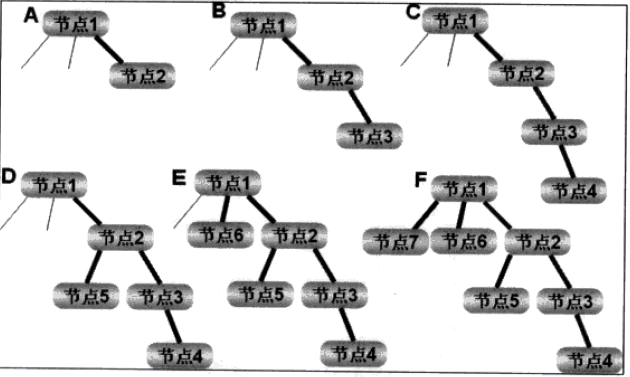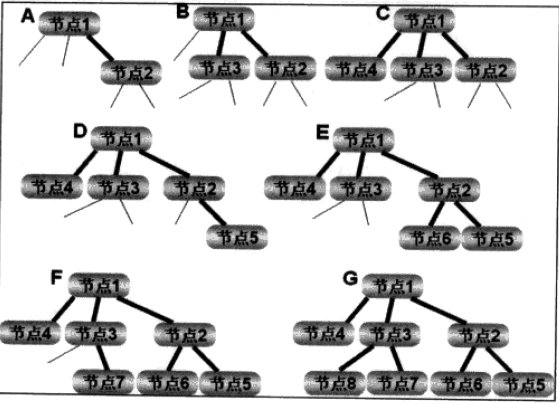本文主要通过基于一张简单的游戏地图,实现深度优先、广度游戏、Dijkstra算法(说明:主要参考了别人滴代码,自己改写了下)。
深度优先算法, 先附截图一张:

深度优先搜索算法在搜索过程中不考虑各个边的开销,只考虑路径的选择,基本思路是:站在一个连通图的的一个节点上,然后尽可能的沿着一条边深入,当遇到死角时回溯,然后继续搜索,直到搜索到目的节点为止,深度优先一般使用栈结构实现,结合上面滴图 , 应该比较容易理解了。
广度优先搜索, 在附截图一张 :

从图就可以很显然的看出,广度优先和深度优先的不同,广度优先是:在一个连通图的节点上依次向下遍历它所有的子节点,直到找到目的节点为止。广度优先一般使用队列结构实现。
Dijkstra算法,依然附上截图二张:



Dijkstra是典型的最短路径搜索算法,一般是从一点出发到另外一点的最短路径,但是它遍历的节点数太多,效率比较底。
分析一下上图: 从节点1出发:可以到达节点为节点3、节点2,比较他们到节点1的距离,将较小的节点2加入最短路径树。在依次比较节点5和节点3的大小,将较小的节点3加入最短路径数,继续比较下去直到搜索到目的节点。
前面滴分析,可能表达滴不太好。 下面是我修改了滴源码,是基于一张简单的地图,在地图上搜索目的节点,依次用深度优先、广度优先、Dijkstra算法实现。
import java.util.ArrayList;
import java.util.HashMap;
import java.util.LinkedList;
import java.util.PriorityQueue;
import java.util.Stack;
/**
*
* @author yinzhuo
*
*/
public class Arithmatic {
boolean flag = true;
// 一张地图
static int[][] map = new int[][]// 地图数组
{
{ 1, 1, 1, 1, 1, 1, 1, 1, 0, 0, 0, 0, 0, 0, 0, 0, 0, 0, 0, 0, 0, 0 },
{ 1, 0, 0, 0, 0, 0, 1, 1, 0, 0, 1, 1, 0, 0, 0, 0, 0, 0, 0, 0, 0, 0 },
{ 1, 0, 0, 0, 0, 0, 1, 1, 0, 0, 1, 1, 0, 0, 0, 0, 1, 1, 0, 0, 0, 0 },
{ 1, 0, 0, 0, 0, 0, 1, 1, 1, 1, 1, 1, 0, 0, 0, 0, 1, 1, 0, 0, 0, 0 },
{ 1, 0, 0, 0, 0, 0, 0, 0, 0, 0, 1, 1, 0, 0, 0, 1, 1, 1, 1, 0, 0, 0 },
{ 1, 0, 0, 0, 0, 0, 1, 1, 1, 0, 1, 1, 0, 0, 0, 0, 1, 1, 0, 0, 0, 0 },
{ 1, 0, 0, 0, 0, 0, 1, 1, 1, 0, 1, 1, 0, 0, 0, 0, 1, 1, 0, 0, 0, 0 },
{ 1, 0, 0, 0, 0, 0, 1, 1, 1, 0, 1, 1, 0, 0, 0, 0, 0, 0, 0, 0, 0, 0 },
{ 1, 1, 1, 0, 0, 1, 1, 1, 1, 0, 1, 1, 0, 0, 0, 0, 0, 0, 0, 0, 0, 0 },
{ 1, 1, 1, 0, 0, 1, 1, 1, 1, 0, 1, 1, 0, 0, 0, 0, 0, 1, 1, 0, 0, 0 },
{ 0, 0, 0, 0, 0, 0, 0, 0, 0, 0, 1, 1, 0, 0, 0, 0, 0, 1, 1, 0, 0, 0 },
{ 0, 0, 1, 0, 0, 1, 1, 1, 1, 1, 1, 1, 0, 0, 0, 0, 1, 1, 1, 1, 0, 0 },
{ 1, 1, 1, 0, 0, 1, 1, 1, 1, 1, 1, 1, 1, 1, 0, 0, 1, 1, 1, 1, 0, 0 },
{ 1, 1, 1, 0, 0, 1, 1, 1, 1, 1, 1, 1, 1, 1, 0, 0, 0, 1, 1, 0, 0, 0 },
{ 1, 0, 0, 0, 0, 0, 0, 0, 0, 0, 0, 0, 0, 0, 0, 0, 0, 0, 0, 0, 0, 0 },
{ 1, 0, 0, 0, 0, 0, 0, 0, 0, 0, 0, 0, 0, 0, 0, 0, 0, 0, 0, 0, 0, 0 },
{ 1, 1, 1, 0, 0, 1, 1, 1, 1, 1, 1, 0, 0, 1, 1, 1, 1, 1, 1, 0, 0, 0 },
{ 0, 0, 1, 0, 0, 0, 0, 0, 0, 0, 0, 0, 0, 0, 1, 1, 1, 1, 0, 0, 0, 0 },
{ 0, 0, 0, 0, 0, 0, 0, 0, 0, 0, 0, 0, 0, 0, 1, 1, 1, 1, 0, 0, 0, 0 },
{ 0, 0, 0, 0, 0, 1, 1, 1, 1, 1, 1, 0, 0, 0, 1, 1, 1, 1, 0, 0, 0, 0 },
{ 1, 1, 1, 0, 0, 0, 0, 0, 1, 1, 1, 0, 0, 0, 0, 0, 0, 0, 0, 0, 0, 0 },
{ 1, 1, 1, 0, 0, 0, 0, 0, 1, 1, 1, 0, 0, 0, 0, 0, 0, 0, 0, 0, 0, 0 },
{ 1, 1, 1, 0, 0, 0, 0, 0, 1, 1, 1, 0, 0, 0, 0, 0, 0, 0, 0, 0, 0, 0 } };
//深度优先所使用的栈
Stack<int[][]> stack = new Stack<int[][]>();
HashMap<String,int[][]> hm=new HashMap<String,int[][]>();//结果路径记录
//出发点
int[] source = {2,2};
//目标点
int[] target = {21,22};
//已经访问过的点
int[][] visited=new int[map.length][map[0].length];//0 未去过 1 去过
//当前点的八方
int[][] sequence={
{0,1},{0,-1},
{-1,0},{1,0},
{-1,1},{-1,-1},
{1,-1},{1,1}
};
//访问经过的路径总长度
int count = 0;
LinkedList<int[][]> queue = new LinkedList<int[][]>();
//记录到每个点的最短路径 for Dijkstra
HashMap<String,ArrayList<int[][]>> hmPath=new HashMap<String,ArrayList<int[][]>>();
//记录路径长度 for Dijkstra
int[][] length=new int[map.length][map[0].length];
/**
* @param args
*/
public static void main(String[] args) {
Arithmatic a = new Arithmatic();
System.out.println("-----------深度优先搜索算法实现---------");
a.DFS();
System.out.println(a.count);
int[] temp = a.target;
while(true){
int[][] tempA=a.hm.get(temp[0]+":"+temp[1]);
System.out.println("(" + tempA[0][0] + "," + tempA[0][1] + ")" + "--" + "(" + tempA[1][0] + "," + tempA[1][1] + ")");
if(tempA[1][0]==a.source[0]&&tempA[1][1]==a.source[1]){//判断有否到出发点
break;
}
temp=tempA[1];
}
// for(int i = 0; i < a.stack.size(); i++){
// System.out.println("(" + a.stack.get(i)[0][0] + "," + a.stack.get(i)[0][1] + ")" + "--" + "(" + a.stack.get(i)[1][0] + "," + a.stack.get(i)[1][1] + ")");
// }
a.visited=new int[map.length][map[0].length];
System.out.println("-----------广度优先搜索算法实现---------");
a.BFS();
System.out.println(a.count);
temp = a.target;
while(true){
int[][] tempA=a.hm.get(temp[0]+":"+temp[1]);
System.out.println("(" + tempA[0][0] + "," + tempA[0][1] + ")" + "--" + "(" + tempA[1][0] + "," + tempA[1][1] + ")");
if(tempA[1][0]==a.source[0]&&tempA[1][1]==a.source[1]){//判断有否到出发点
break;
}
temp=tempA[1];
}
// for(int i = 0; i < a.queue.size(); i++){
// System.out.println("(" + a.queue.get(i)[0][0] + "," + a.queue.get(i)[0][1] + ")" + "--" + "(" + a.queue.get(i)[1][0] + "," + a.queue.get(i)[1][1] + ")");
// }
a.visited=new int[map.length][map[0].length];
System.out.println("----------Dijkstra算法实现--------------");
a.Dijkstra();
System.out.println(a.count);
ArrayList<int[][]> alPath=a.hmPath.get(a.target[0]+":"+a.target[1]);
for(int[][] t: alPath){
System.out.println("(" + t[0][0] + "," + t[0][1] + ")" + "--" + "(" + t[1][0] + "," + t[1][1] + ")");
}
}
/**
* 深度优先搜索算法
*/
public void DFS() {
//开始路径
int[][] start = {{source[0],source[1]},{source[0],source[1]}};
stack.push(start);
while(flag){
int[][] currentEdge=stack.pop();//从栈顶取出边
int[] tempTarget=currentEdge[1];//取出此边的目的点
//判断目的点是否去过,若去过则直接进入下次循环
if(visited[tempTarget[1]][tempTarget[0]]==1){
continue;
}
count++;
visited[tempTarget[1]][tempTarget[0]]=1;//标识目的点为访问过
//记录此临时目的点的父节点
hm.put(tempTarget[0]+":"+tempTarget[1],new int[][]{currentEdge[1],currentEdge[0]});
//判断有否找到目的点
if(tempTarget[0]==target[0]&&tempTarget[1]==target[1]){
break;
}
//将所有可能的边入栈
int currCol=tempTarget[0];
int currRow=tempTarget[1];
//将它的周围相连点都加入到栈中
for(int[] rc:sequence){
int i=rc[1];
int j=rc[0];
if(i==0&&j==0){continue;}
if(currRow+i>=0&&currRow+i<map.length&&currCol+j>=0&&currCol+j<map[0].length&&
map[currRow+i][currCol+j]!=1){
//将此边入栈
int[][] tempEdge={
{tempTarget[0],tempTarget[1]},
{currCol+j,currRow+i}
};
stack.push(tempEdge);
}
}
}
}
/**
* 深度优先算法
*/
public void BFS(){
count = 0;
hm.clear();
//开始路径
int[][] start = {{source[0],source[1]},{source[0],source[1]}};
queue.offer(start);
while(flag){
int[][] currentEdge=queue.poll();//从队首取出边
int[] tempTarget=currentEdge[1];//取出此边的目的点
//判断目的点是否去过,若去过则直接进入下次循环
if(visited[tempTarget[1]][tempTarget[0]]==1){
continue;
}
count++;
visited[tempTarget[1]][tempTarget[0]]=1;//标识目的点为访问过
//记录此临时目的点的父节点
hm.put(tempTarget[0]+":"+tempTarget[1],new int[][]{currentEdge[1],currentEdge[0]});
//判断有否找到目的点
if(tempTarget[0]==target[0]&&tempTarget[1]==target[1]){
break;
}
//将所有可能的边入队列
int currCol=tempTarget[0];
int currRow=tempTarget[1];
for(int[] rc:sequence){
int i=rc[1];
int j=rc[0];
if(i==0&&j==0){continue;}
if(currRow+i>=0&&currRow+i<map.length
&&currCol+j>=0&&currCol+j<map[0].length&&
map[currRow+i][currCol+j]!=1){
int[][] tempEdge={
{tempTarget[0],tempTarget[1]},
{currCol+j,currRow+i}
};
queue.offer(tempEdge);
}
}
}
}
/**
* 广度优先A*算法
*/
public void BFSAStar(){
}
/**
* Dijkstra算法
*/
public void Dijkstra(){
for(int i=0;i<length.length;i++){
for(int j=0;j<length[0].length;j++){
length[i][j]=9999;//初始路径长度为最大距离都不可能的那么大
}
}
count = 0;
int[] start={source[0],source[1]};//开始点col,row
visited[source[1]][source[0]]=1;
for(int[] rowcol:sequence){//计算此点所有可以到达点的路径及长度
int trow=start[1]+rowcol[1];
int tcol=start[0]+rowcol[0];
//超出地图
if(trow<0||trow>18||tcol<0||tcol>18)continue;
//碰到墙壁
if(map[trow][tcol]!=0)continue;
//记录路径长度
length[trow][tcol]=1;
//计算路径
String key=tcol+":"+trow;
ArrayList<int[][]> al=new ArrayList<int[][]>();
al.add(new int[][]{{start[0],start[1]},{tcol,trow}});
hmPath.put(key,al);
count++;
}
//bre跳出循环标记
bre:while(flag){
//找到当前扩展点K 要求扩展点K为从开始点到此点目前路径最短,且此点未考察过
int[] k=new int[2];
int minLen=9999;
for(int i=0;i<visited.length;i++){
for(int j=0;j<visited[0].length;j++){
if(visited[i][j]==0){
if(minLen>length[i][j]){
minLen=length[i][j];
k[0]=j;//col
k[1]=i;//row
}
}
}
}
visited[k[1]][k[0]]=1;//设置去过的点
int dk=length[k[1]][k[0]];//取出开始点到K的路径长度
ArrayList<int[][]> al=hmPath.get(k[0]+":"+k[1]);//取出开始点到K的路径
//循环计算所有K点能直接到的点到开始点的路径长度
for(int[] rowcol:sequence){
int trow=k[1]+rowcol[1];//计算出新的要计算的点的坐标
int tcol=k[0]+rowcol[0];
//若要计算的点超出地图边界或地图上此位置为障碍物则舍弃考察此点
if(trow<0||trow>map.length-1||tcol<0||tcol>map[0].length-1)continue;
if(map[trow][tcol]!=0)continue;
int dj=length[trow][tcol];//取出开始点到此点的路径长度
int dkPluskj=dk+1;//计算经K点到此点的路径长度
//若经K点到此点的路径长度比原来的小则修改到此点的路径
if(dj>dkPluskj){
String key=tcol+":"+trow;
//克隆开始点到K的路径
ArrayList<int[][]> tempal=(ArrayList<int[][]>)al.clone();
//将路径中加上一步从K到此点
tempal.add(new int[][]{{k[0],k[1]},{tcol,trow}});
//将此路径设置为从开始点到此点的路径
hmPath.put(key,tempal);
//修改到从开始点到此点的路径长度
length[trow][tcol]=dkPluskj;
//若此点从未计算过路径长度则将此点加入考察过程记录
if(dj==9999){//将去过的点记录
count++;
}
}
//看是否找到目的点
if(tcol==target[0]&&trow==target[1]){
//终止循环
break bre;
}
}
}
}
}






















 721
721

 被折叠的 条评论
为什么被折叠?
被折叠的 条评论
为什么被折叠?








